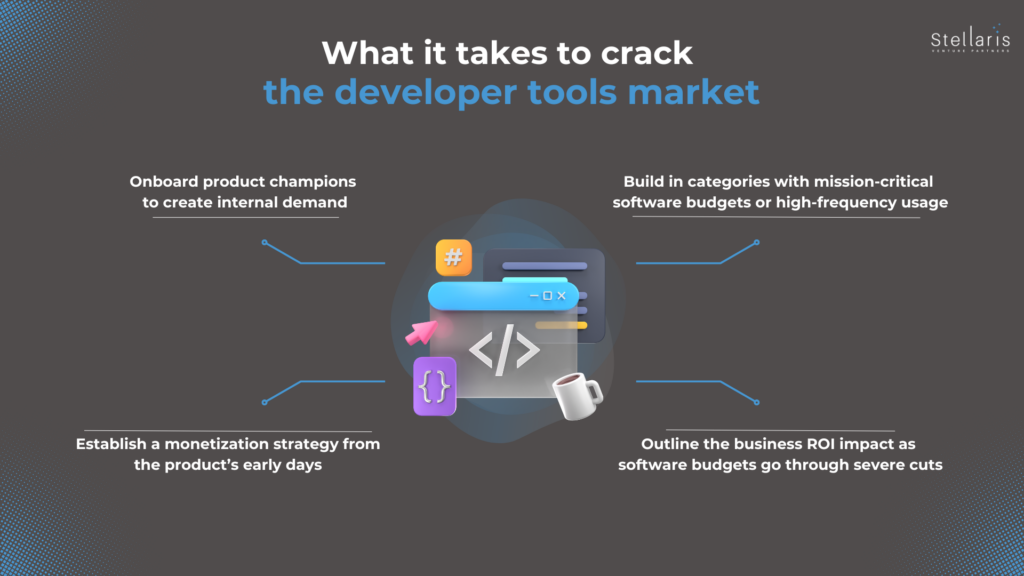The last decade has seen rapid changes in software development – agile development, APIs, microservices, OSS and the growth of AI-first and data companies. All of these have led to the creation of a large number of developer tool companies. Over the past few years, the share of developer-focused companies relative to application software companies has increased substantially as well. Great developer-focused companies like Postman and Browserstack have emerged from India. We’ve also seen India become the second-largest market of developers globally, with the number of developers crossing 5 million and increasing compensation parity compared to developed markets like the US.
Building any successful company is hard, but we believe building a successful developer-focused company is even harder. Though there will be opportunities to build large companies as new technologies proliferate, the right to win in this market is characterised by multiple factors. Below, we have outlined these characteristics based on our observations and conversations with engineering leaders regarding their experiences with buying, selling, and using developer tools over the past year.

A product that shines in the developer market must take several factors into account, including monetisation, building for the right usage, and onboarding product champions.
You would need product champions to create internal demand
Our conversations with multiple engineering leaders revealed that only 30% of a developer’s time is spent on writing code, while about 70% is spent on non-development tasks. This statistic highlights the critical need for tools that can streamline operations, automate repetitive tasks, and enhance productivity.
Despite acknowledging this inefficiency, developers, as a collective, are not a curious bunch when it comes to exploring new products. Only 10-20% of developers within an organisation tend to fall in the category of explorers. Even if the pain is well recognized, developers are often inclined towards building internal solutions using open-source technologies instead of opting for external solutions, a mindset stemming from their need for flexibility and trust.
For a company building developer tools, it is important to onboard the “curious” developer as their champion, as developers rarely adopt a product when pushed from the top-down. It is important to focus on identifying and engaging these more “curious” users as word-of-mouth-driven network effects in the developer world are much stronger than for business applications, making these early champions invaluable.
Focus on building in categories with mission-critical software budgets or high-frequency and collaborative usage
The number of tools that developers tend to use frequently is extremely low, with most of them ending up working with a common set of popular IDEs, Github, and coding co-pilots. There are 100s of paid tools solving for niche use cases and each use case will have numerous open source alternatives that are causing massive fragmentation in the market, leading to poor monetisation.
For any external tool to be bought or adopted by developers, you need either of these two drivers:
- Solution to a mission-critical problem with large budgets to tap into – eg. observability, security, CI/CD
- High-frequency usage and strong collaboration – eg. Github co-pilot, Postman
While PLG solves for adoption, monetisation will be sales-led
Though PLG solves for quick adoption (and is important for building champions and establishing developer love), monetization mostly depends on sales-led motions. The prevalence of cumbersome approval processes in these accounts pose significant barriers to adoption. Overcoming these challenges requires a nuanced understanding of the decision-making dynamics within organisations, demonstrating business ROI and a focus on driving widespread adoption rather than solely targeting developer personas. Even in large devtool companies with significant bottom-up adoption and low ACVs, we’ve seen a top-down sales approach with high ACV strategy being implemented to increase revenues (eg. Gitlab, Cloudflare).
Open source has been a popular go-to-market (GTM) strategy for developer tools in the last decade. The two most important value propositions that open source products provide are flexibility and trust. In our understanding, an open source strategy serves as more of a wedge to attract early users and bootstrap adoption but it is crucial to identify a value proposition that customers are willing to pay for. Over the last few years, we have seen that open source adoption has not translated into revenue traction, primarily because a monetization strategy was not in place from the product’s early days.
It will be important to outline the business ROI impact as software budgets go through severe cuts
The stark disparities in willingness to pay across organisational structures underscores the importance of pricing strategies that align with the developer persona, market realities and perceived value.
Developers have a significantly low willingness to pay. Across our conversations, developers in India are comfortable paying $10-$20/seat/month for a product they are using frequently vs. developers in the USA who are willing to pay $25-$50/seat/month. In the world of developers, there’s a common sentiment: why pay for something when you can build it yourself? If the price of a tool is high, a developer wants to build it in-house, even if the cost of building exceeds that of buying.
In an environment characterised by budget cuts and internal tooling initiatives, the onus is on companies to demonstrate to developers the superior value proposition of external solutions over in-house alternatives. It is also important to show technical leaders the challenges of maintaining some of these internal products especially in environments of workforce attrition.
We believe that 2024 is going to be yet another exciting year for developer tools and the venture ecosystem. If you’re a founder, investor, operator, or enthusiast in this space, please write to us at sayantan@stellarisvp.com or nj@stellarisvp.com and we would love to talk.

